Karle
What Is A Chaitya Hall?
- The Buddhist Prayer – Hall.
- Large – vaulted hall with apsidal end and divided longitudinally by two colonnades into a broad nave and two aisles.
- Stupa in the apse.
- Aisles and apsidal end for circumambulation and nave for congregational service.
Why A Chaitya Hall?
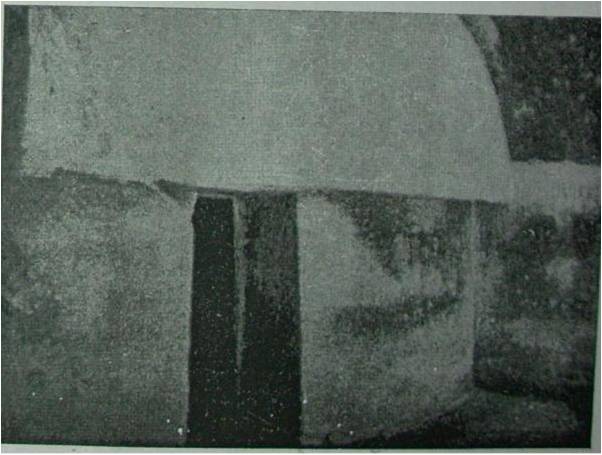
The Stupa evolved from being a funerary mound carrying ashes to an object of worship.
- Carried the ashes of the Buddha so gained a sacral value.
- A building was needed to accommodate copies of the Stupa and provide shelter for devotees.
- Initially religious rites were conducted in the open, so no need for a structural house of prayer.
- As Idol worship evolved, temples to house deities were required.
- In order to house a hemispherical Stupa and to provide for circumambulation building which was circular in plan and had a domed roof was made.
- Accepted as was sanctified by bee hive huts and conical roofs of hermits.
Birth Of The Basilica – Shaped Hall
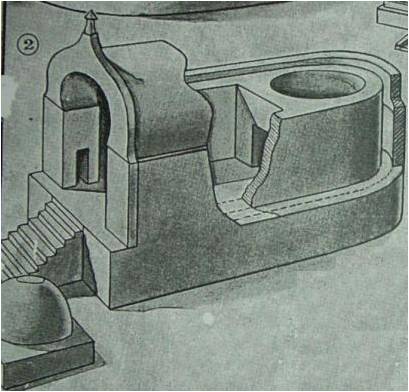
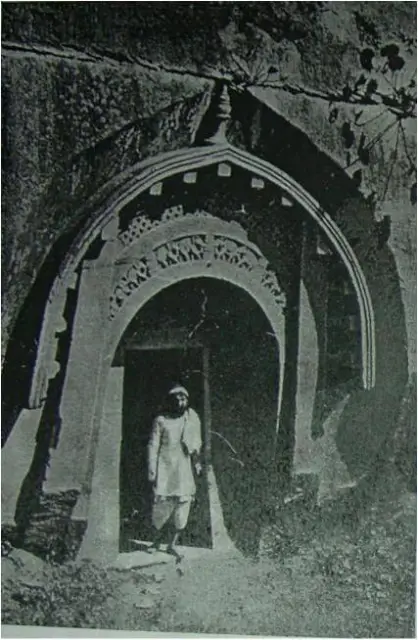
- Rock – cut chambers of Barabar Hills, Bihar were predecessors of the Basilica – shaped hall.
- Inner cells are copies of circular huts with thatched roofs and overhanging eaves.
- Rock cut chamber at Guntupalle is a copy of a circular hut with the conical thatched roof resting like an inverted basket on the wood frame, stupa being in situ.
- Barrel – vaulted ante – chamber attached to inner cellar with a doorway in between.
- An example is of Taxila, 1st century B.C.
- Wall separating cellar from ante – chamber was removed, and Basilica shaped hall formed.
- Earliest example is Temple No. 40 at Sanchi.
Temple No. 40, Sanchi

- Exterior plan is rectangular, but one end of interior plan is apsidal.
- Unusually high plinth in order to raise building above flood level in low plains.
- Side entrances copied from rock – cut chapels which were so due to shallow contouring of quarried rock.
- Row of pillars aligned down center of nave.
- Built mainly of wood. Wooden pillars and railings and timber roof covered with tiles.
Chaitya Halls Of The Hinayan Period
- Chaitya halls at Bhaja, Kondane, Pitalkhora, 9th and 10th caves at Ajanta, Bedsa, Nasik and Karle.
- Karle is the most important and best executed.
- Bhaja, Kondane, Pitalkhora and the 10th cave at Ajanta in the 2nd century B.C.
- Bedsa, Nasik, Karle and the 9th cave at Ajanta in the 1st century B.C.
- Last Chaitya hall at Kanheri in the middle of the 2nd century, A.D.
- The earlier the building, the closer it copies timber construction.
- The slope of the interior pillars helps decide chronology. The inward slope is a derivation of wooden posts slanted to take the thrust of the heavy timber roof, hence greater the angle, older the hall.
- The chronology also depends on the Chaitya arch.
General Characteristics
- Apsidal plan.
- Pillars in colonnades are copies of plain wooden posts, of octagonal section and without capitals and base.
- Massive pillared portico or vestibule in front.
- Behind is a façade consisting of a great horse – shoe archway with a wall or screen below, and doorways accessing the nave and aisles.
- There is a sun window in the centre of the archway to let in sunlight.
- It is a stilted semi – circular aperture, divided into lunettes (an area framed by an arch or vault) using curved wooden transoms (a crossbar dividing a window horizontally) held by wooden braces and radiating like spokes of a wheel.
Bhaja
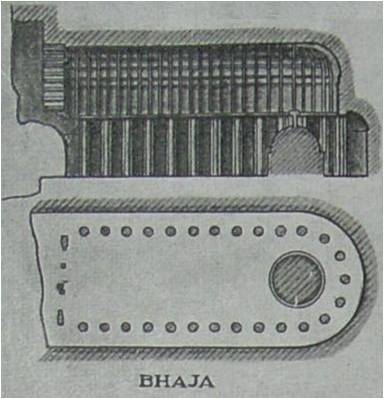
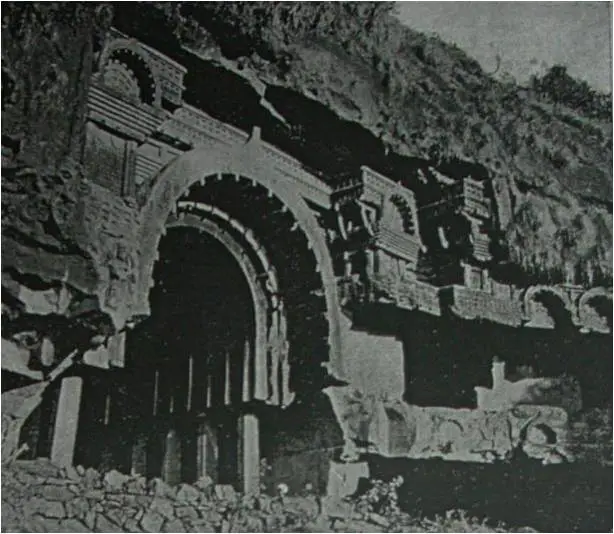
- Most primitive hall.
- 55ft X 26 ft, side aisles 3 ½ ft wide and high – stilted vault 29 ft high with close ranked wood ribs.
- Façades have numerous mortice holes for fixing elaborate wooden frontages.
- H – shaped framework in the front with the two uprights fitting into each side of the rock – cut archway and the horizontal beam connecting and holding them acting as a cross – piece.
- Screen with one central and 2 side doorways under the arch.
- Hanging balcony supported on 4 pillars above cross – beam constituting a portico.
- Stupa consists of a cylindrical base, tall domical body and a wooden harmika and chhatri.
Kondane
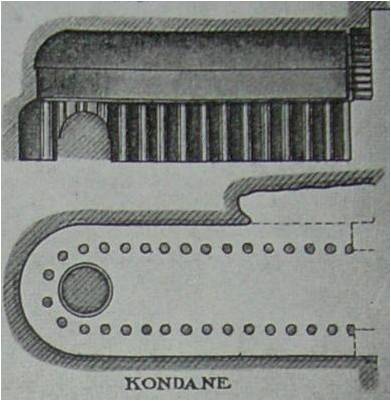
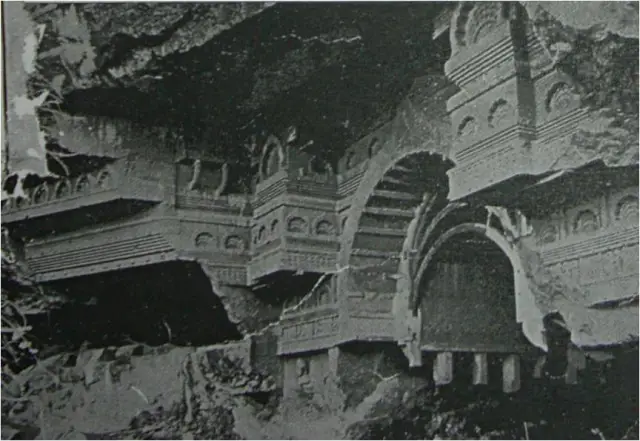
- 66 ft X 26 ½ ft X 28 ft.
- Next step in evolution of Chaitya halls.
- Structure similar to Bhaja.
- Upright beams on both sides of the archway are partially stone carved instead of fully in wood.
Pitalkhora
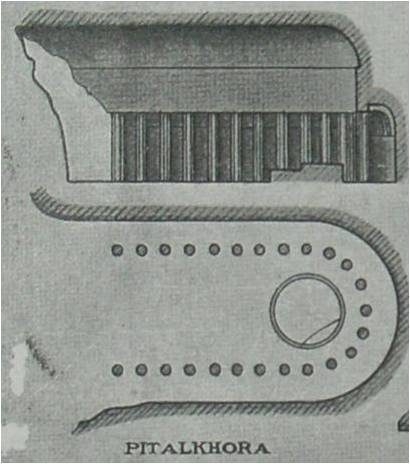
- 50 ft X 34 ½ ft X 31 ft.
- Roof – ribs in side – aisles carved of rock.
Ajanta Cave 10
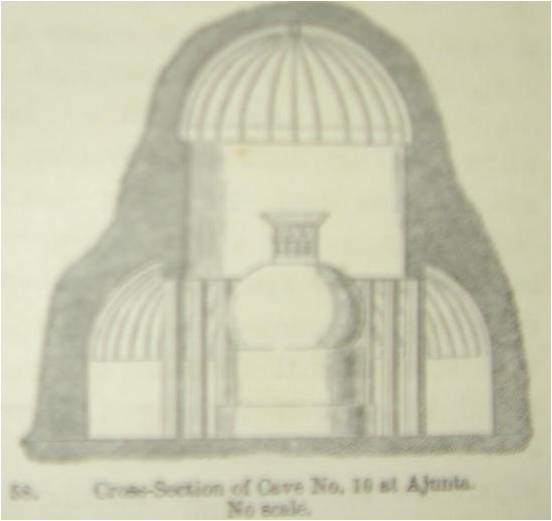
- 100 ft X 40 ft X 33 ft.
- Roof – ribs in side – aisles radiate from end pillars and carved of rock.
- Two tiered stupa with circular base, and elongated dome.
Ajanta Cave 9
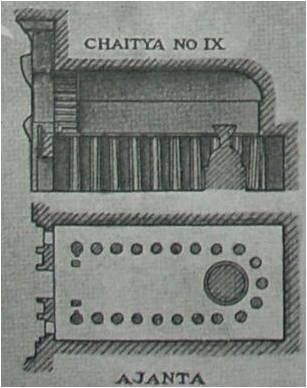
- Entire hall rock carved.
- Rectangular plan. The ceilings of the side aisles is flat with perpendicular pillars.
- Doorway in the centre and a window on either side, each topped by an elegant cornice on brackets like a portico.
- Broad sill or ledge on top with a sun window above within a Chaitya arch. There are small lattice windows carved around the archway.
- The wooden ribs bracing the vault of the nave have been removed leaving a broad space like a triforium.
Bedsa
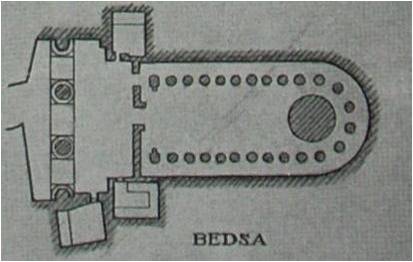
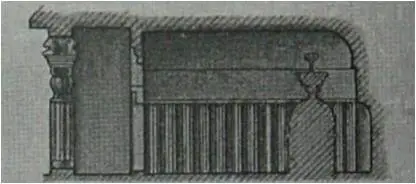
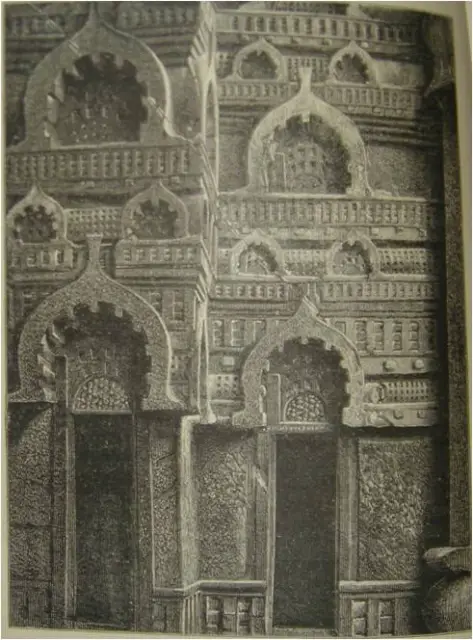
- 45 ½ ft X 21 ft.
- Exterior consists of two rock cut columns between pilasters acting as a vestibule to the arcaded screen at the rear.
- Vase – shaped base, octagonal shaft and figurine carved capital.
- Pillars support the main beam of the roof.
- Beams, binding joists and railing parapet copied from timber construction.
- The archway, sun window, and entrance doorway are within the portico.
- Interior is very plain, pillars are copies of octagonal posts.
Karle
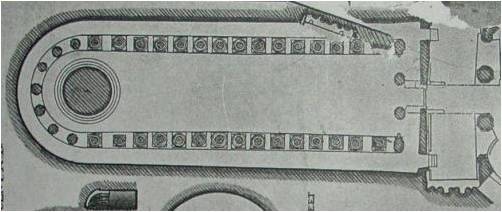
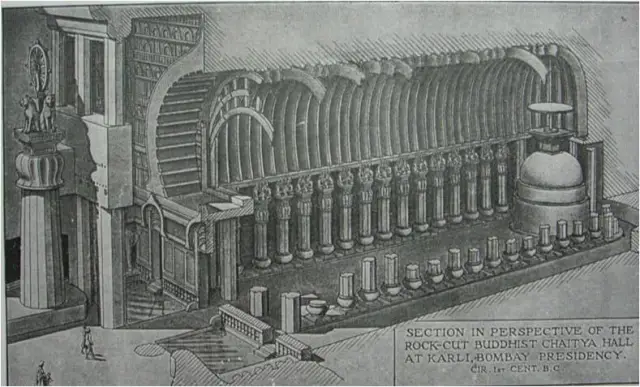
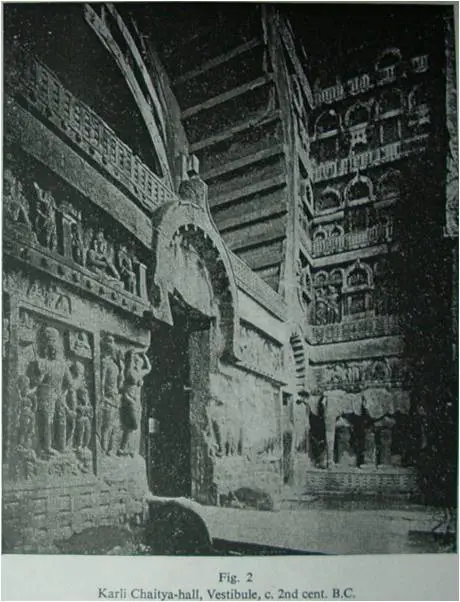
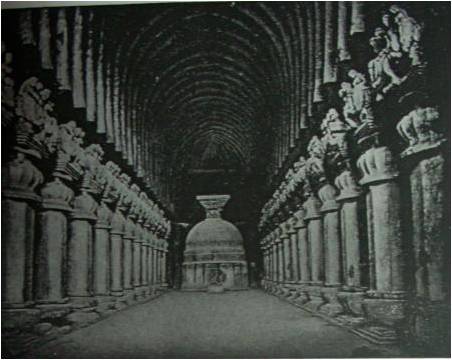
- Pinnacle of Hinayana Chaitya construction.
- 124 ft X 46 ½ ft X 45 ft.
- At the front are the SIMHA STAMBHA; 50 ft tall free standing pillars on both sides of the façade, placed ahead of the entrance to inspire reverence.
- Each stands on a wide rock cylinder base, with a 16 – sided shaft, fluted abacus above the capital and a harmika pedestal for wheel bearing lions.
- Behind them is a vestibule, the front made of a rock cut screen with a triple entrace and pillared clerestory. There are mortice holes to attach a wooden gallery accessible by stairs behind the column.
- Inner wall of the vestibule has a horse – shoe archway with a recessed sun window. Rock tiers of arcading separated by railings are carved on the spandrils.
- Entrance was by 3 doorways, approached by a raised pathway. On each side the sunken floor formed shallow cisterns for water.
- There are pillared aisles, with 37 closely set pillars. The ones encircling the apse have unadorned octagonal shafts.
- 15 on each side of the colonnade are highly decorated like the SIMHA STAMBHA. Each has a vase base on a plinth, octagonal shaft, campaniform capital with abacus an statuary.
- High arched vault with narrow projecting ribs (wind braces) of flat planks of wood attached by plugs or socketed in grooves.
- The Stupa is like the one at Bedsa.
- The sun – window lets in light. It is first filtered between clerestory openings, then the wooden grill of the window.
Kanheri
- Last Hinayana Chaitya Hall, 2nd Century A.D.
- 86 ft X 40 ft X 50 ft.
- There is a courtyard in front of the exterior contained within a small wall and accessible by steps.
- Within it are SINHA STAMBHAS as at Karle but these are attached to rock. Also there is a cushion member in between the octagonal shaft.
- The outer façade is a plain wall screen with three tall square openings below and a 5 window clerestory above.
- There are mortice holes to attach wooden construction, showing that the hall returned to half timber construction.
- Behind the screen is a vestibule with 3 doorways and an unfinished bare semi circular sun window.
Chaitya Halls Of The Mahayana Period
- Rock cut Chaitya halls are not stone copies of timber construction.
- Only timber framework with curved transoms in Chaitya window and ribs of the vault resemble woodwork.
- Workmen more aware of the material, carved solid rock to make structures instead of copying slender wooden beams and joinery.
- Cushion capital developed. The shaft is a plain square prism, the upper being round in section, vertically fluted with compressed capital.
Ajanta Cave No 19
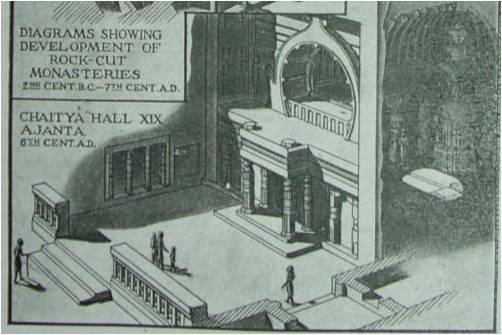
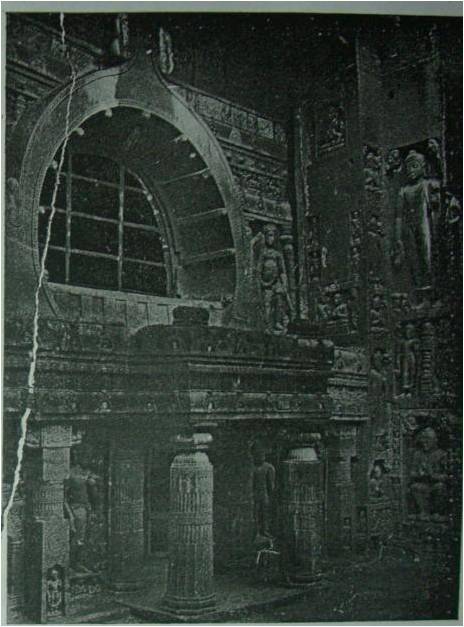
- Exterior 38 ft X 32 ft, interior 46 ft X 24 ft.
- Exterior entrance court with side chapels, with one doorway and pillared portico. The roof of the portico forms an entablature with a minstrel’s gallery on it. Chaitya window at the back.
- Interior divided into nave and aisles by 15, 11 ft high, pillars with patterned shafts, cushion capitals and brackets supporting a 5 ft wide triforium.
- Vaulted roof with carved ribs.
- Stupa is a monolith 22 ft high, double domed. The domical portion is a pillared niche and canopy with the Buddha in the recess.
- Above is a tall tiered finial, a harmika, 3 decreasing parasols and a vase.
Ajanta Cave No 26
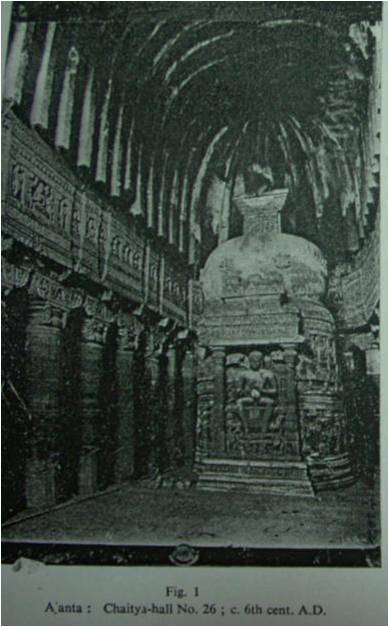
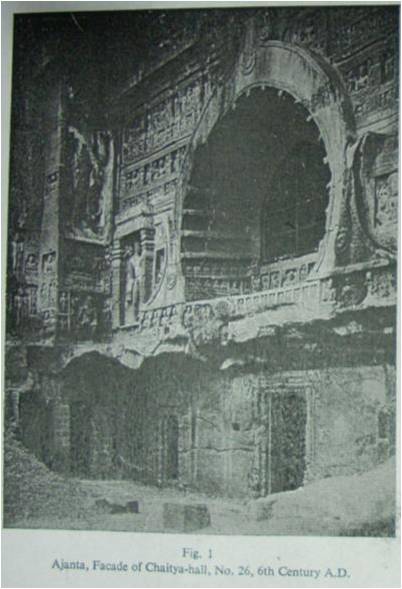
- 68 ft X 36 ft X 31 ft.
- Last Ajanta Hall, 50 years after no. 19
- More ornamented, a member added in the pillars, panels recessed and elaborate triforium.
- Portico has 3 doorways with Chaitya window above.
- Decline of style signaled by excessive sculpture and shoddy workmanship.
Mahanwada Cave
- 117 ft X 58 ½ ft.
- Down the center of the nave two low narrow and parallel platforms left in rock. Used to seat priests in two facing rows.
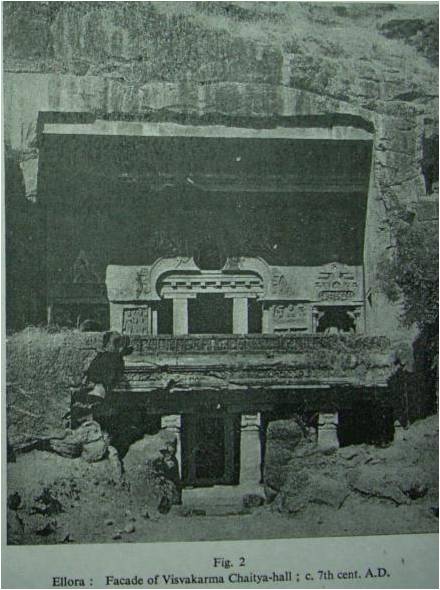
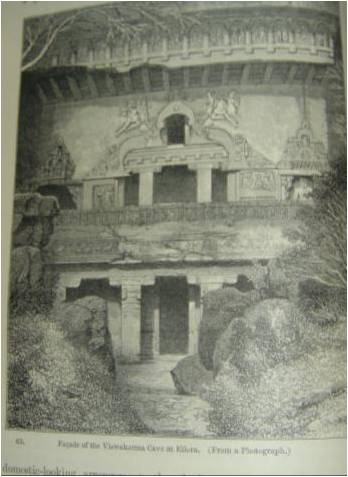
Viswakarma Cave
- 85 ft X 44 ft x 34 FT.
- Plainer than Ajanta.
- Stupa is a foundation to support a shrine or niche of Buddha.
- Chaitya arch of the sun window compressed to a small opening, with a transverse foliation below.
- Two canopies over the niche, predecessors of Indo Aryan and Dravidian temple shrine styles.
Evolution Of Chaitya Arch
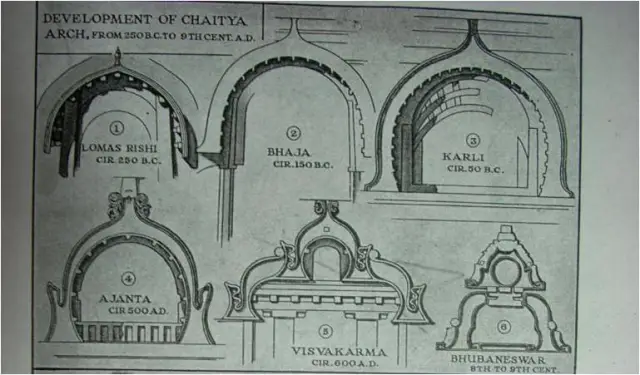
- Lomas Rishi had a gable end, an arrangement of boards.
- First horse – shoe at Bhaja but stilted.
- Arch at Kondane has an inward return to the spring.
- At Ajanta and Karle it reaches its pinnacle.
- During Mahayana period at Ajanta the arch becomes constricted at the base and florid in curves.
- At Viswakarma its almost a circle.
- Ornamental accessory in Brahmanical temples.

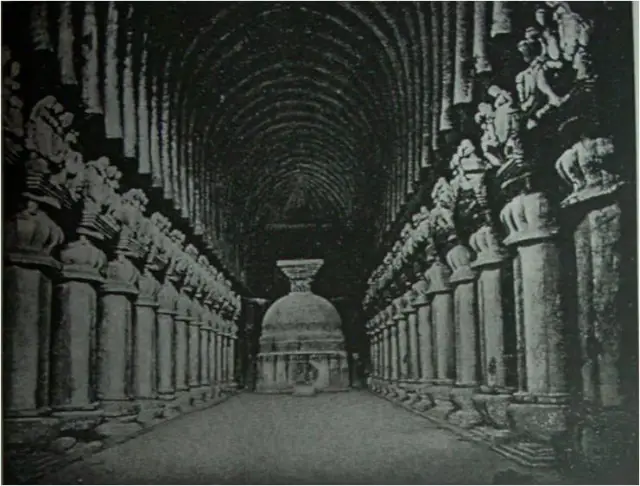
Leave a Reply
You must be logged in to post a comment.